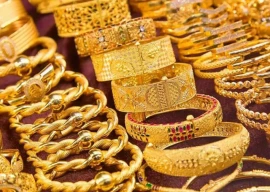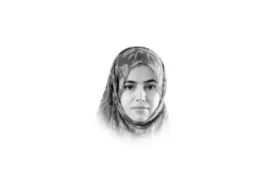
Looking beneath the surface
Mazhar was drafted by Pursukoon Karachi, a non-profit organisation comprising nine artists, sculptors and architects, to restore the 150-year-old building, stripping it of false ceilings, poor paint jobs, shoddily constructed additions and several coats of crimson paan stains.

Initially, the Pursukoon group planned to have the station cleaned and painted. “Once I saw the building’s original yellow stone, however, I said we needed to remove all the layers of paint and concrete in order to restore the original structure.” For four months, Mazhar worked for free on a few parts of the station, in what became a litmus test for her ability to work with the building and the many challenges it presented. “I might have worked for free, but for me, the barter made sense. If I was successful, I had the job. And who else would let me touch a 19th century building at this age?” she shares.
In the absence of substantial archival photographs, blueprints or notes, the project required a fair amount of detective work. Mazhar stumbled upon photographs and log notes from the time of the railway’s construction in 1865 in London’s British Library. One morning, she spotted a slightly raised curve under layers of paint and concrete and guessed that an arch must be hidden underneath. The first glimpse of the original slate, grey stone floors came from a small patch inside the security officials’ offices.

The ticket office after it was restored. PHOTO COURTESY: MARVI MAZHAR & ASSOCIATES
Many times, the material would confound Mazhar’s expectations or local architects and engineers would question her approach. “When we started chipping off the layers of marble and concrete, they were coming off in sheets and I was very nervous about what I’d find underneath,” she says. “One engineer warned me that the building was weak and wouldn’t withstand the process. But I remembered what Yasmeen Lari would always say when it came to heritage buildings: ‘You’ve got to remove all the concrete and you’ve got to let the building breathe.’” Thus, much of the work was informed by a previous conservation project undertaken by the Heritage Project on Karachi’s Denso Hall in 2010.
Mentors such as Bilgrami and Kamil Khan Mumtaz also helped soothe the nerves. “There was one area of the station where the original yellow stone was turning black,” Mazhar recalls. A hastily-organised visit to the station by Khan confirmed that the stone was simply ‘breathing’ after decades of being blanketed by concrete and fungus was growing on the wall.

Irum, a police official, keeps an eye on a bank of CCTV feeds inside the offices for security staff. PHOTO CREDIT: ARIF SOOMRO
The station’s booking office was the first hurdle for the team. Ticket officers sat on plastic chairs atop a three-foot-high concrete slab to be able to reach the ticket counter. A small square skylight had been punched into the false ceiling and a ticket box from colonial times was propped up next to a barred window. Additionally, rusting aluminum cabinets lined the wall, stuffed with paperwork. The air conditioner never cooled enough and the false ceiling was warped by humidity.
Today, there is no need for an air conditioner there. “This building was constructed keeping the weather of Pakistan in mind,” explains Mazhar. Once the team got rid of the false ceiling and restored the windows to their natural height and removed the concrete slabs and bars from the windows, the humidity was taken care of. Light now streams into the high-ceilinged room while the ticket officers perch on high wooden chairs rescued and restored from the station’s warehouse. Mazhar’s team stripped the office’s original doors of seven layers of oil paint and fixed the original lock. The old English ticketing boxes have been polished to a high gleam. “The officers wanted new ticket boxes, but we didn’t see the point in doing that when the colonial ones had survived so beautifully,” she explains.
“Building bohot fit hai abhi (The building is in great condition no),” comments one of the ticket officers as he punches out a business class ticket from one of the ticket box’s narrow metal slots. “Dil khush hota hai yahaan beth kar (one feels happy sitting here),” he adds. He then leans back in his chair and says something you would never expect from a government servant: “I find this office very relaxing to be in now.”
Money matters
For the last six months, however, work has ground to a halt at the station as funds have dried up. While the Pursukoon team grew accustomed to receiving financial support from the provincial government and private donors in small bursts, this has been the longest period where there have been no donations.

Signs put up at the station by the restoration team. PHOTO CREDIT: ARIF SOOMRO
The Pursukoon team initially received Rs5,000,000 from the provincial government, part of which was utilised for a three-day festival in Karachi in 2013. The remainder and an additional Rs2,500,000, given by Sindh chief minister Qaim Ali Shah, was poured into the restoration project. Government officials and political leaders, including Sherry Rehman, Nafisa Shah and the special assistant to the chief minister on culture, Sharmila Farooqi, have even visited the station to learn more about the project and have all praised the initiative. Why the lack of funding then one may ask. Farooqi shares that the Pursukoon team approached her a week before the provincial budget was to be announced. “If they had approached the government earlier, we could have kept money aside for such a project, but at the moment, we cannot siphon money from other projects to keep this one going,” she adds.
At times when there was no funding, the team would just sit around and make sketches documenting the building and its transformation. They worked piecemeal throughout the station, restoring small portions with whatever funds were available at the time. As a result, the building seems to be a bizarre amalgamation of styles, both modern and colonial.
Interventions: where old meets new
While the two styles don’t make for the best of appearances, it’s the perfect reminder of why the restoration project is so vital. For instance, on one side of the same wall one can see caramel-coloured stone, almost the colour and texture of warm unleavened bread, and when one turns slightly to the right they’ll see whitewashed concrete and perhaps the faint raised curve of an arch that has been bricked over and cemented.
The station’s two faces also raise the question on why some interventions, such as ‘no guns allowed’ signs and spikes atop pillars to ward off pigeons, are deemed ‘good’, whereas other additions, such as a staircase that bisects the ticket office, built to save officials the hassle of walking to either end of the station to go to the upper floors, are considered ‘bad’. Before installing anything, however, the team looks at what masters have done in other parts of the world. “While a staircase ruins the purity of the building, anything we have added on does not impact the structure and can be removed whenever we want. For instance, none of the signs are nailed on.”

Kamil Khan Mumtaz examines a patch of fungus on the original stone wall. PHOTO COURTESY: MARVI MAZHAR
Some interventions, however, do not seem to be particularly successful. Outside the station, a small water body has been built where previously trees and benches offered travellers respite from the sun. The tiled pool is currently dry and people have thrown wrappers and bottles inside it. Sometimes, they even dip their feet in the water, leaving dirt and leaves behind. “We’re always debating the additions we have made,” Mazhar says. The Pursukoon team agreed to allot a small archway to the Citizens Archive of Pakistan (CAP), a not-for-profit organisation dedicated to preserving the stories of generations of Pakistanis. Here, CAP’s oral histories and photographs are displayed for any traveller or coolie to pore over. But Mazhar assures that the CAP space or the water body can be assessed in three months to see how people have reacted to it. “If it hasn’t worked for them, we’ll give the space back to the railway department,” she says.
Building a future by consensus
Curator, artist and one of the founding members of Pursukoon Karachi Noorjehan Bilgrami estimates that the project requires at least another Rs30,000,000. Farooqi has promised to speak with the chief minister to see if the money can be allocated for the project within or outside of the budget. However, she adds, the Pursukoon team would have to meet with the culture department’s director works to discuss where the money will be funnelled.

Bilgrami insists that a working relationship can be forged and is greatly appreciative of the federal government’s support. But it is impossible to ignore the fact that the restoration team works primarily to remove traces of successive governments’ decisions within the station. On Mazhar’s first day at the station, she battled with officials as she tried to remove political posters and banners plastered onto the walls. While many workers said they were too scared to pull down the posters, others simply refused to do so until a rival political party’s posters were also removed.

At three points in the station, the Pursukoon team has left ‘layers of memory’ — reminders of the damage done to the building — within clear acrylic boxes. On one pillar in the main hall, one can see 22 layers of oil paint that were slapped onto the original structure. “I am guessing that a new coat of paint was added on every time a government official would visit the station,” Mazhar says. In another box, one can see how marble was layered on concrete and stone in order to sheath the original stone walls. “Before a funding period would lapse, officials would add on another layer onto the walls rather than fix what was already there, all in the name of ‘maintaining’ the building,” she explains. “We keep these layers of memory so we are able to show them to all government officials who visit the station.”

“Of course, that was not the right thing to do,” concedes Farooqi. “But until someone doesn’t catch the people who do this, you have no idea that this is what is happening.”
There have been tussles, both internal and with the government, about plans for the station. Some have proposed the addition of cafes or shops to boost the station’s income, while others, such as architect Habib Fida Ali, have instantly shot down such suggestions. Meanwhile, Mazhar suggests that each archway on the station’s upper floor, with a beautiful view of swaying banyan trees, be fitted with tables and chairs and WiFi so it can be ‘rented’ out for hours at a time to writers, journalists, artists or anyone looking for a quiet spot.

Bilgrami points out that while there may be a difference of aesthetics between government teams and the Pursukoon artists and architects, many of these differences have been smoothed over through dialogue. For example, while railway officials wished to construct a rockery outside the station, the Pursukoon team convinced them that travellers would be better served by benches and trees in the spot. “Look, at the end of the day, if something has to be done correctly, we have to explain it to those in charge and hope that they understand,” Bilgrami says. Compromise is also required from Pursukoon, simply because, as she puts it, “at the end of the day, it all boils down to the money.”
Sanam Maher is a senior subeditor at The Express Tribune national desk. She tweets @SanamMKhi
Published in The Express Tribune, Sunday Magazine, February 1st, 2015.























COMMENTS
Comments are moderated and generally will be posted if they are on-topic and not abusive.
For more information, please see our Comments FAQ